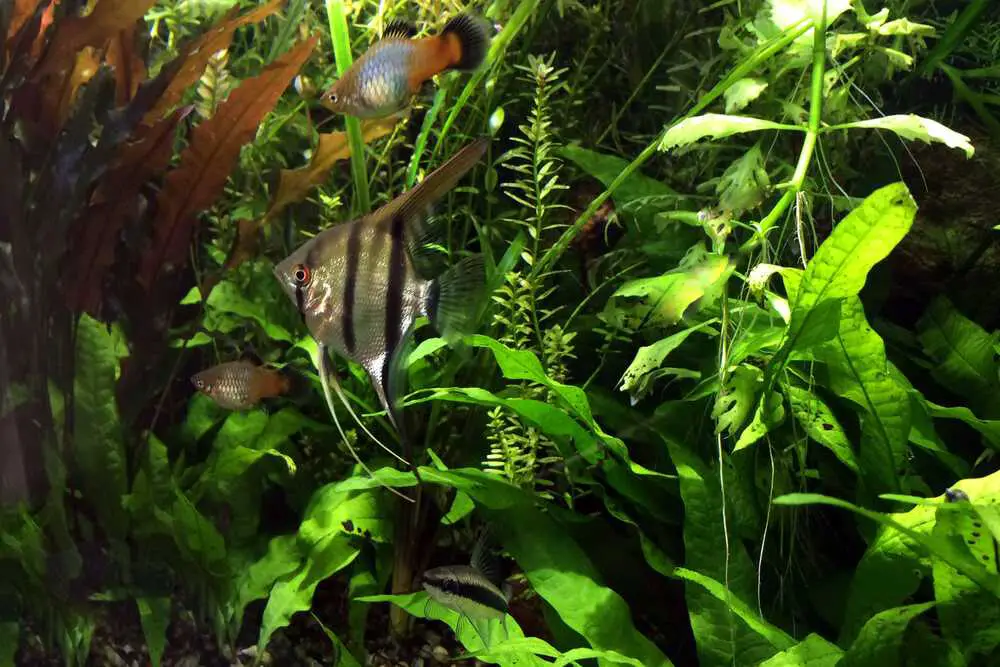Java fern is a popular aquarium plant because it’s easy to care for and adds a natural touch to your aquarium.
However, sometimes Java fern can develop black spots on its leaves, which can be alarming if you’re not sure what’s causing them.
Read on to learn about the 3 most common reasons for Java fern black spots and actionable solutions.
3 Reasons Why Java Fern Develop Black Spots And How To Fix It
#1. Development Of New Root
It’s common for Java ferns to develop black spots on their leaves as they age. These spots are actually a natural part of the plant’s growth process!
Java ferns propagate through their leaves, and the black spots are the first sign of new roots starting to grow.
Over time, these roots will grow bigger and more visible; eventually, little leaves will appear.
TIP: The uniform, bumpy black spots on your Java fern leaves indicate that new leaves are beginning to grow. You may also notice small, hairy growths at the leaves’ tips, which are a new plant’s roots.
These roots will eventually grow into new leaves, making your Java fern bigger and more beautiful.
When you feel your Java fern has grown enough, you can snip off the leaf with the new growth and plant it elsewhere.
SOLUTION: Sometimes, your Java fern may look rough due to all the black roots, but don’t worry! This is a normal part of the plant’s growth process. As the new leaves grow bigger, your Java fern will double in size and become even more beautiful.
So, if you see black spots on your Java fern, know it’s a good sign of new growth, and don’t be too concerned. Just make sure to give your plant proper care, and it will continue to thrive.
#2. Leaves Burned By Lighting
If you notice dark brown or black patches (spots) on the Java fern leaves, it’s likely a sign of being burned by excessive lighting in your tank.
If you see small, round black spots on your Java fern leaves, it indicates that baby plants are about to sprout.
These spots, called nodes, are where new growth occurs. On the other hand, if you see larger, irregularly shaped dark patches on your Java fern leaves, it may be a sign of decay.
Decay is a process that occurs when a plant’s tissue starts to break down and deteriorate.
SOLUTION: Java fern is a versatile plant that can thrive in various lighting conditions. But it does best in low light, so it’s a good choice for areas of your tank that doesn’t get much direct light.
To provide your Java fern with the best light, you can use a 6700k spectrum bulb. This type of lighting is perfect for Java ferns and will help the plant grow strong and healthy.
Your Java Fern needs at least six hours of light daily, regardless of your chosen intensity. Keep in mind that if you do leave the plant out in the sun, it might easily dry out or become burnt. Black or brown spots becomes noticeable on the leaves of a burnt plant.
#3. Potassium Deficiency
One possible reason for the dark spots on your Java fern is a nutritional deficiency, especially potassium deficiency.
Potassium is an important nutrient that helps plants grow strong and healthy, and Java fern is especially sensitive to this nutrient.
If your Java fern is not getting enough potassium, it may develop distinctive pinholes on its leaves, which can be rimmed with brown or yellow.
SOLUTION: To solve the potassium deficiency in java fern, you can use a supplement that helps elevate potassium levels.
Or you can also use an all-in-one fertilizer to treat the problem. All-in-one fertilizers contain various essential nutrients, including potassium, that plants need to thrive.
So by dosing your tank with an all-in-one fertilizer, you can help ensure that your Java fern is getting all the nutrients it needs to grow strong and healthy.
To use an all-in-one fertilizer, follow the instructions on the package and adjust the dosage as needed.
Be sure to use the fertilizer according to the recommended frequency and dosage, as overfertilization can harm your plants.
On the other hand, regular fertilization can help prevent potassium deficiency and keep your Java fern healthy and beautiful.
Seachem Flourish is a popular – general fertilizer that helps deal with plant nutrient deficiencies. Check Seachem Flourish here (on Amazon).
Does Black Spots In Java Fern Mean It’s Dying?
Black spots on Java ferns are not always a cause for concern. Instead, these spots can signify java fern propagation, as young plants often sprout from these areas.
So if you see black spots on your Java fern, don’t panic – it could just be a natural part of the plant’s growth process.
However, if the black spots do not appear to be producing new plants, it may be a sign that the plant is in trouble.
In this case, it’s a good idea to wait a day or two to see if the spots show any signs of new growth.
If you don’t see any new plants sprouting, it may be a sign that the plant is dying and may need to be removed.
Overall, black spots on Java ferns are not always a cause for concern, but it’s important to keep an eye on the plant and take action if necessary to ensure its health and growth.
Typically, Java fern leaves may become brown or transparent as plants age, but they produce new plants along the leaf margins before that occurs. This promotes the expansion of Java ferns in their environment.
Wrapping Up
It’s common for Java ferns to need a little more growth before they begin developing optimally. This might be because they are still adjusting to their new environment or need more time to mature.
Be patient and allow your Java fern enough time to develop, regardless of the cause. Java ferns may not be fast growers, but they are adaptable and may thrive in various environments.
If you want your Java fern to thrive, remove any damaged leaves and replant the ones that have sprouted from the leaf margins. With enough time and attention, a Java fern can flourish and become an attractive centerpiece for your aquarium.
In short, if you notice black spots on your Java fern, don’t worry! With a little attention to its care, you can help prevent further black spots from appearing.
Follow all the causes and solutions to troubleshoot the black spot issue on your java fern.
With proper lighting conditions, care, and nutrition, your Java fern will thrive and be a beautiful addition to your planted aquarium.
Hi! I’m Praveen Ghoshal, the founder of eFishkeeping.com. Inspired by my Dad, I got interested in fishkeeping when I was a kid. Since then, I have been involved with this hobby. Currently, I have 3 fish tanks at our home, and I enjoy this hobby with my full family. Read more about me here.


![Why Are Anubias So Expensive? [Reasons + Cheap Alternatives] why-are-anubias-so-expensive](https://efishkeeping.com/wp-content/uploads/2022/12/anubias-in-a-planted-aquarium-300x200.jpg)




![Anubias Has Holes In Leaves? [Top 5 Causes And Solutions] anubias-has-holes-in-leaves](https://efishkeeping.com/wp-content/uploads/2023/04/anubias-has-holes-in-leaves-300x202.jpg)